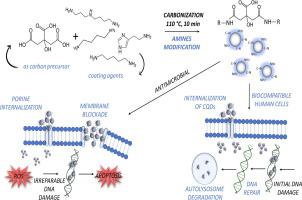Journal of Colloid and Interface Science ( IF 9.9 ) Pub Date : 2020-07-05 , DOI: 10.1016/j.jcis.2020.06.125 Milica Gagic 1 , Silvia Kociova 1 , Kristyna Smerkova 2 , Hana Michalkova 1 , Milena Setka 3 , Pavel Svec 1 , Jan Pribyl 4 , Jiri Masilko 5 , Radka Balkova 5 , Zbynek Heger 2 , Lukas Richtera 2 , Vojtech Adam 2 , Vedran Milosavljevic 2

|
In the present study, the thermal decomposition of citric acid in the presence of biogenic amine was used to synthesize four different functionalized carbon quantum dots (CQDs), namely, histamine-(HCQDs), putrescine-(PCQDs), cadaverine-(CCQDs) and spermine-(SCQDs). The thermal decomposition of the precursors resulted in a decrease in stability and the formation of surface amides via a cross-linking process between the carboxyl and amine groups. The deposition of biogenic amines was confirmed by a structural characterization of the synthesized CQDs. The resulting CQDs, with a net zero charge, exhibited excellent stability in environments with different pH values. Through a set of different cytotoxicity tests, the absence of gene mutations, apoptosis, necrosis or disruption in cell membranes revealed the high biocompatibility of the CQDs. The antimicrobial activity of the synthesized CQDs was investigated against different bacterial species (Staphylococcus aureus, Escherichia coli, and Klebsiella pneumonia). We determined the growth kinetics, production of reactive oxygen species (ROS), cell viability and changes in membrane integrity by scanning electron microscopy (SEM). The minimal inhibitory concentrations (MICs) for S. aureus ranged from 3.4 to 6.9 µg/mL. Regarding E. coli and K. pneumonia, all CQD formulations reduced growth, and the MICs were determined for CCQDs and HCQDs (6.9–19.4 µg/mL). The antibacterial activity mechanism was attributed to the oxidative stress generated after CQD treatment, which resulted in the destabilization of the bacterial membrane. The bacterial permeability to propidium iodide indicated a change in membrane integrity, and the effect of CQDs on the morphology of the bacterial cells was evidenced by SEM.
中文翻译:

一锅法合成具有抗菌活性的天然胺改性生物相容性碳量子点。
在本研究中,柠檬酸在生物胺存在下的热分解用于合成四种不同的功能化碳量子点(CQDs),即组胺-(HCQDs)、腐胺-(PCQDs)、尸胺-(CCQDs)和精胺-(SCQDs)。前体的热分解导致稳定性降低,并通过羧基和胺基之间的交联过程形成表面酰胺。通过合成的 CQD 的结构表征证实了生物胺的沉积。所得的 CQD 具有净零电荷,在不同 pH 值的环境中表现出优异的稳定性。通过一系列不同的细胞毒性测试,细胞膜中没有基因突变、凋亡、坏死或破坏,揭示了 CQD 的高生物相容性。金黄色葡萄球菌、大肠杆菌和肺炎克雷伯菌)。我们通过扫描电子显微镜 (SEM) 确定了生长动力学、活性氧 (ROS) 的产生、细胞活力和膜完整性的变化。金黄色葡萄球菌的最低抑菌浓度 (MIC)范围为 3.4 至 6.9 µg/mL。关于大肠杆菌和肺炎克雷伯菌,所有 CQD 配方都减少了生长,并且确定了 CCQD 和 HCQD (6.9–19.4 µg/mL) 的 MIC。抗菌活性机制归因于CQD处理后产生的氧化应激,导致细菌膜不稳定。细菌对碘化丙啶的渗透性表明膜完整性发生了变化,扫描电镜证明了 CQDs 对细菌细胞形态的影响。


























 京公网安备 11010802027423号
京公网安备 11010802027423号